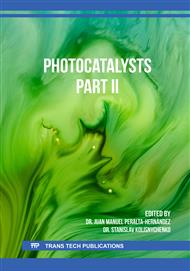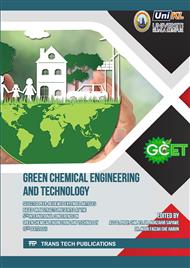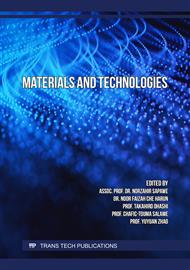[1]
S. Lamichhane, K.C.B. Krishna and R. Sarukkalige, Polycyclic aromatic hydrocarbons (PAHs) removal by sorption: A review, Chemosphere, 148 (2016) 336–353.
DOI: 10.1016/j.chemosphere.2016.01.036
Google Scholar
[2]
G.N. Ijoma and M. Tekere, Potential microbial applications of co-cultures involving ligninolytic fungi in the bioremediation of recalcitrant xenobiotic compounds, Int. J. Environ. Sci. Technol., 14 (2017) 1787–1806.
DOI: 10.1007/s13762-017-1269-3
Google Scholar
[3]
N. Agrawal, P. Verma and S.K. Shahi, Degradation of polycyclic aromatic hydrocarbons (phenanthrene and pyrene) by the ligninolytic fungi Ganoderma lucidum isolated from the hardwood stump, Bioresour. Bioprocess., 5 (2018) 11.
DOI: 10.1186/s40643-018-0197-5
Google Scholar
[4]
S. Rostami, A. Azhdarpoor and M.R. Samaei, Removal of Pyrene from Soil Using Phytobioremediation (Sorghum Bicolor-Pseudomonas), Heal. Scope, (2017).
DOI: 10.5812/jhealthscope.62153
Google Scholar
[5]
B.T.P. Jian, M.R.U. Mustafa, M.H. Isa, A. Yaqub and H.Y. Chia, Study of the water quality index and polycyclic aromatic hydrocarbon for a river receiving treated landfill leachate, Water (Switzerland), 12 (2020) 1–29.
DOI: 10.3390/w12102877
Google Scholar
[6]
A. Baheti, C.P. Lee, K.R.J. Thomas and K.C. Ho, Pyrene-based organic dyes with thiophene containing π-linkers for dye-sensitized solar cells: Optical, electrochemical and theoretical investigations, Phys. Chem. Chem. Phys., 13 (2011) 17210–17221.
DOI: 10.1039/c1cp21714c
Google Scholar
[7]
A. Baali and A. Yahyaoui, Polycyclic Aromatic Hydrocarbons (PAHs) and Their Influence to Some Aquatic Species, Biochem. Toxicol. - Heavy Met. Nanomater., (2020).
DOI: 10.5772/intechopen.86213
Google Scholar
[8]
J.K. Ma et al., Effects of Pyrene on Human Liver HepG2 Cells: Cytotoxicity, Oxidative Stress, and Transcriptomic Changes in Xenobiotic Metabolizing Enzymes and Inflammatory Markers with Protection Trial Using Lycopene, Biomed Res. Int., (2019).
DOI: 10.1155/2019/7604851
Google Scholar
[9]
R.A. Baan, B.W. Stewart and K. Straif, Tumour Site Concordance and Mechanisms of Carcinogenesis, France, (2019).
Google Scholar
[10]
Sakshi, S.K. Singh and A.K. Haritash, Catabolic enzyme activity and kinetics of pyrene degradation by novel bacterial strains isolated from contaminated soil, Environ. Technol. Innov., 23 (2021) 101744.
DOI: 10.1016/j.eti.2021.101744
Google Scholar
[11]
L. Ping, Q. Guo, X. Chen, X. Yuan, C. Zhang and H. Zhao, Biodegradation of pyrene and benzo[a]pyrene in the liquid matrix and soil by a newly identified Raoultella planticola strain, 3 Biotech, 7 (2017).
DOI: 10.1007/s13205-017-0704-y
Google Scholar
[12]
X. Li et al., Anaerobic biodegradation of pyrene by Klebsiella sp. LZ6 and its proposed metabolic pathway, Environ. Technol. (United Kingdom), 41 (2020) 2130–2139.
DOI: 10.1080/09593330.2018.1556348
Google Scholar
[13]
P. Wanapaisan et al., Synergistic degradation of pyrene by five culturable bacteria in a mangrove sediment-derived bacterial consortium, J. Hazard. Mater., 342 (2018) 561–570.
DOI: 10.1016/j.jhazmat.2017.08.062
Google Scholar
[14]
A.K. Mukherjee, P. Bhagowati, B.B. Biswa, A. Chanda and B. Kalita, A comparative intracellular proteomic profiling of Pseudomonas aeruginosa strain ASP-53 grown on pyrene or glucose as sole source of carbon and identification of some key enzymes of pyrene biodegradation pathway, J. Proteomics, 167 (2017).
DOI: 10.1016/j.jprot.2017.07.020
Google Scholar
[15]
S.R. Subashchandrabose, K. Venkateswarlu, R. Naidu and M. Megharaj, Biodegradation of high-molecular weight PAHs by Rhodococcus wratislaviensis strain 9: Overexpression of amidohydrolase induced by pyrene and BaP, Sci. Total Environ., 651 (2019) 813–821.
DOI: 10.1016/j.scitotenv.2018.09.192
Google Scholar
[16]
A. Nzila, C.O. Ramirez, M.M. Musa, S. Sankara, C. Basheer and Q.X. Li, Pyrene biodegradation and proteomic analysis in Achromobacter xylosoxidans, PY4 strain, Int. Biodeterior. Biodegrad., 130 (2018) 40–47.
DOI: 10.1016/j.ibiod.2018.03.014
Google Scholar
[17]
N. Tahri, W. Bahafid, H. Sayel and N.E. Ghachtouli, Biodegradation: Involved Microorganisms and Genetically Engineered Microorganisms, Biodegrad. - Life Sci., (2013).
DOI: 10.5772/56194
Google Scholar
[18]
H. Soni, N. Kumar, K. Patel and R.N. Kumar, Investigation on the Heterogeneous Photocatalytic Remediation of Pyrene and Phenanthrene in Solutions Using Nanometer TiO2 under UV Irradiation, Polycycl. Aromat. Compd., 40 (2020) 257–267.
DOI: 10.1080/10406638.2017.1411956
Google Scholar
[19]
D. Dong et al., Photocatalytic degradation of phenanthrene and pyrene on soil surfaces in the presence of nanometer rutile TiO2 under UV-irradiation, Chem. Eng. J., 158 (2010) 378–383.
DOI: 10.1016/j.cej.2009.12.046
Google Scholar
[20]
N. Aiin et al., Removal of fluoranthene and pyrene from rainwater using solar/TiO2 photocatalysis: Optimization study, 2332 (2021) 70001.
Google Scholar
[21]
J.H. Carey, J. Lawrence and H.M. Tosine, Photodechlorination of PCB's in the presence of titanium dioxide in aqueous suspensions, Bull. Environ. Contam. Toxicol., 16 (1976) 697–701.
DOI: 10.1007/bf01685575
Google Scholar
[22]
D. Chen et al., Photocatalytic degradation of organic pollutants using TiO2-based photocatalysts: A review, J. Clean. Prod., 268 (2020).
Google Scholar
[23]
S. Kanan, M.A. Moyet, R.B. Arthur and H.H. Patterson, Recent advances on TiO2-based photocatalysts toward the degradation of pesticides and major organic pollutants from water bodies, Catal. Rev. - Sci. Eng., 62 (2020) 1–65.
DOI: 10.1080/01614940.2019.1613323
Google Scholar
[24]
A. Mishra, A. Mehta, S. Kainth and S. Basu, A comparative study on the effect of different precursors for synthesis and efficient photocatalytic activity of g-C3N4/TiO2/bentonite nanocomposites, J. Mater. Sci., 53 (2018) 13126–13142.
DOI: 10.1007/s10853-018-2565-0
Google Scholar
[25]
S.J. Phang, J.M. Goh, L.L. Tan, W.P.C. Lee, W.J. Ong and S.P. Chai, Metal-free n/n–junctioned graphitic carbon nitride (g-C3N4): a study to elucidate its charge transfer mechanism and application for environmental remediation, Environ. Sci. Pollut. Res., 28 (2021) 4388–4403.
DOI: 10.1007/s11356-020-10814-z
Google Scholar
[26]
H.Y. Xu, L.C. Wu, H. Zhao, L.G. Jin and S.Y. Qi, Synergic Effect between Adsorption and Photocatalysis of Metal-Free g-C3N4 Derived from Different Precursors, PLoS One, 10 (2015).
DOI: 10.1371/journal.pone.0142616
Google Scholar
[27]
M. Nageeb, Adsorption Technique for the Removal of Organic Pollutants from Water and Wastewater, in Organic Pollutants - Monitoring, Risk and Treatment, InTech, (2013).
DOI: 10.5772/54048
Google Scholar
[28]
Z. Luo et al., Comparison of g-C3N4 synthesized by different precursors in remediation of phenanthrene contaminated soil and ecotoxicity, J. Photochem. Photobiol. A Chem., 389 (2020).
Google Scholar
[29]
F. Dong et al., In situ construction of g-C3N4/g-C3N4 metal-free heterojunction for enhanced visible-light photocatalysis, ACS Appl. Mater. Interfaces, 5 (2013) 11392–11401.
DOI: 10.1021/am403653a
Google Scholar
[30]
J. Zhang, S. Fan, B. Lu, Q. Cai, J. Zhao and S. Zang, Photodegradation of naphthalene over Fe3O4 under visible light irradiation, R. Soc. Open Sci., 6 (2019).
DOI: 10.1098/rsos.181779
Google Scholar
[31]
M.M. Mohamed and S.A. Ahmed, Pd-doped β-Bi2O3/Bi2Sn2O7 hybrid nanocomposites for photocatalytic fluorene oxidation: A green approach for the synthesis of fluorenone/fluorenol mixture, Microporous Mesoporous Mater., 204 (2015) 62–72.
DOI: 10.1016/j.micromeso.2014.11.004
Google Scholar
[32]
M. Umar and H.A. Aziz, Photocatalytic Degradation of Organic Pollutants in Water | IntechOpen, (2013). [Online]. Available: https://www.intechopen.com/books/organic-pollutants-monitoring-risk-and-treatment/photocatalytic-degradation-of-organic-pollutants-in-water.
DOI: 10.5772/53699
Google Scholar
[33]
Q. Zhang et al., Advanced Fabrication of Chemically Bonded Graphene/TiO2 Continuous Fibers with Enhanced Broadband Photocatalytic Properties and Involved Mechanisms Exploration, Sci. Rep., 6 (2016).
DOI: 10.1038/srep38066
Google Scholar





